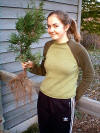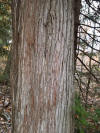Wholesale & Retail Sales
|
The Hanlon Family
Pat & Laura, Molly
Hanlon Sundstrom |
(231)544-6769 |
American Arborvitae, White Cedar, Eastern ArborvitaeTHUJA OCCIDENTALIS Habitat. Hardy zone 3-7. A native of eastern North America. Arborvitae also called White Cedar is a handsome pyramidal evergreen shrub or tree with foliage varying from dark green to light green during the growing season. Arborvitae can grow to 60' and is considered a slow to medium grower. An interesting ability of the American Arborvitae is it's ability to overcome adversity in it's favored habitat. White Cedar grows well in wet areas and will grow equally well on dry sandy hill tops. White Cedar likes high humidity and tolerates wet soils and some drought, but not salt exposure of any kind. Leaves. The foliage on Arborvitae is scale like, flat with inconspicuous buds and can brown somewhat during the winter months. Some of the Arborvitae cultivars retain their green foliage well into winter. Flowers. Flowers in May, purplish on tips of side twigs; pistillate on different branches. Fruit. The Arborvitae cones are about 1/2" long, about the size of an Eastern Hemlock Winter Buds. White Cedar buds are somewhat difficult to discern from last years growth Bark. The arborvitae bark is gray-brown somewhat similar to Ironwood (Ostrya virginiana) and peels off readily in June when making fence posts. Wear rubber gloves as the sap will stain your hands. We can't get a wheeled vehicle in our cedar swamps so I have to carry them out on my shoulder. If the poles are left in the woods for a couple weeks they will lose nearly half their weight from sap evaporating thus making them much lighter when carrying them out of the woods. Wood. The wood is light, soft, brittle, rather coarse grained, durable, fragrant, pale yellow-brown, with thin, whitish sapwood. White cedar wood weighs 19 pounds per cubic foot when dry. Uses. Here at the farm we use white cedar for fence posts and lumber. My neighbor "Bub" has a home made sawmill run off an old John Deere with a leather belt connected to a Pinto transmission with a 42" saw blade on a homemade carriage. Bub is near 90 and still runs his mill a few times a year. Also used for shingles, siding, porches, interior walls and railroad ties. Pests. Pests of the White Cedar are
Arborvitae leaf miner which mines out the leaf tips, causing them to
turn brown. Scales of several types infest the stems and foliage.
Mites cause yellowing and speckling of the foliage. Bagworms can
devour large quantities of foliage very quickly. Fletcher scale over
winters as a small, reddish brown nymph on twigs and needles of the
white cedar. The over wintering females are out when the redbuds are
blooming. Juniper scale causes a yellowing of the needles. Females
over winter as adults with eggs, there is only one generation per
year. The crawlers emerge in early June in Michigan. , spruce spider
mites, tip blight, phytophthora root rot. Distribution. SE Canada to NE Minnesota to northern Wisconsin, North Michigan, New York, Vermont and north. Other. In the wetter areas at Porcupine Hollow if an Arborvitae topples over it will root along the length of the trunk. Arborvitaes have also sprouted from old White Pine stumps cut 100 years ago. The stump will rot away leaving the Arborvitae roots above ground. See the last photo below. Transplanting is moderately easy if plants are root-pruned and either balled and burlapped or grown in rootbags and makes an excellent hedge or screen. Many of the natural stands of Arborvitae in the United States have been cut. Some remain in isolated areas along rivers throughout the East. White cedar are found most commonly mixed with hemlock and yellow birch in low lying areas in the upper Midwest. Arborvitae have shallow root systems when growing on wet ground and can blow over easily. Good survival in ice storms. Arborvitae are widely used as a shrub hedge and can be grown so that the branches are so intertwined as to make an unpenetrateable fence. Arborvitae are also an excellent choice for a windbreak where deer damage is not a problem. See last photo below for deer damage. Arborvitae is the tree of choice in northern areas for fence post and shingles as the wood resist rotting. If you have the time and desire Arborvitae can be rooted easily in the early spring from cuttings. Cultivars. There are at leat 80 cultivars. Brandon: which is resistant to winterburn and grows about 14' tall . Emerald Green: Is a bright green color that holds up well in the winter. Is a narrow grower to about 15' tall by 5' wide and is great for hedges. It also is heat and cold tolerant. Techney: Great for a screen or hedge as it grows 15' and is pyramidal but fairly slow growing. It keeps the deep green foliage thru winter and is very hardy. Dark Green: Also known as nigra arborvitae is a pyramidal and it grows to 25' and a with of 10'. Not quite as green as techney. Green Giant: Fastest growing of the arbs up to 50' and a width of 10-20'. Conical shaped and holds color well. To buy one of the cultivars of white cedar click here. To buy regular Arborvitae also called white cedar seedlings or check price and availability click on the drop down menu below. If no menu appears we are sold out till fall. Call for B+B prices. To order Arborvitae seedling by PHONE: We're glad to take your order by phone. Call 231-544-6769 Phone orders can be charged to VISA, American Express, Disaster or MasterCard accounts. To order Arborvitae seedlings by MAIL: For those who wish to order by mail or prefer to send a check, send orders to: Porcupine Hollow Farm 8593 W. State Rd. Central Lake, Mi. 49622 Order Arborvitae by using our secure shopping cart:
click for more Evergreen prices Shipping & Handling: Most orders are shipped UPS. Make sure we have your street address and a daytime phone number. Please include 20% shipping and packaging with your order. Minimum shipping $15 Michigan Residents add 6% sales tax.
|





